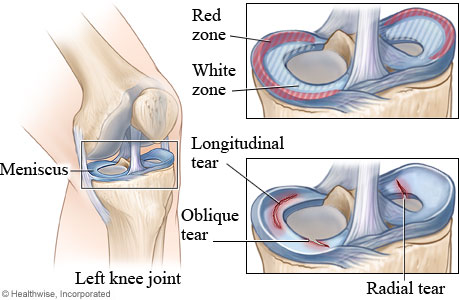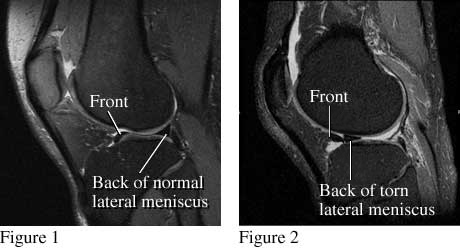Meniscus Tear
A meniscus tear is a common knee injury. The meniscus is a rubbery, C-shaped disc that cushions your knee. Each knee has two menisci (plural of meniscus)—one at the outer edge of the knee and one at the inner edge. They keep your knee steady by balancing your weight across the knee. A torn meniscus can prevent your knee from working right.
Symptoms
Meniscus Tears

Where a meniscus tear occurs is one of the most important things that affects healing. Tears at the outer edge (red zone) tend to heal well because there is a good blood supply. The inner area (white zone) lacks a good blood supply and therefore does not heal well.
The type of tear often determines whether a tear can be repaired. Longitudinal tears are often repairable. Radial tears may be repairable depending on where they are located. Oblique (flap) tears and another type called horizontal tears are generally not repairable.
What are the symptoms of a meniscus tear?
Symptoms of a meniscus tear depend on the size and location of the tear. They also depend on your age and the health of your knee.
Symptoms may include things like knee pain, swelling, or stiffness. It may be hard to walk. Your knee may feel unstable, or it may be hard to straighten all the way. Or you may feel like your knee "catches" when you move.
Some people have severe pain and swelling right away when the tear happens. Or they might have less pain and swelling at first but then notice that it gets worse over a few days.
Older people sometimes don't notice when the tear happens. But then they notice symptoms later.
Causes
What causes a meniscus tear?
A meniscus tear is usually caused by twisting or turning quickly, often with your foot planted while your knee is bent. Meniscus tears can occur when you lift something heavy or play sports. As you get older, your meniscus gets worn. This can make it tear more easily.
Diagnosis
How is a meniscus tear diagnosed?
Your doctor will ask about past injuries and what you were doing when your knee started to hurt. A physical exam will help your doctor find out if a torn meniscus is the cause of your pain. Your doctor will look at both knees and check for tenderness and range of motion and see how stable your knee is.
You may have tests such as X-rays to check the bones of the knee or an MRI, which can give a clear picture of where a tear is and how it might be treated. The doctor may order the MRI if the diagnosis is not clear. You may need to meet with an orthopedic surgeon.
Knee MRI

Courtesy of Intermountain Medical Imaging, Boise, Idaho. All rights reserved.
Figure 1 is a side view of the knee that shows the normal location of the outside, or lateral, meniscus. Figure 2 is a similar view that shows a piece of meniscus that has been torn and moved.
Treatment
How is a meniscus tear treated?
Your choices for treating a torn meniscus are:
- Treatment without surgery. This includes resting, using ice, wrapping the knee in an elastic bandage, propping it up on pillows, and doing physical therapy. This treatment choice may include wearing a temporary knee brace.
- Surgery to sew the tear together.
- Surgery to remove the torn section of the meniscus.
- Surgery to remove the entire meniscus.
There are many things to think about when deciding how to treat a torn meniscus. These things include where the tear is and how serious it is, your pain level, your age and activity level, your doctor's preference, and when the injury happened. The decision about whether to have surgery depends on the kinds of symptoms you have and how bad they are, not just on how big the tear is. You may have a large tear but still decide not to have it repaired.
Meniscus repair is more successful if:
- You are younger. Experts think people younger than about age 40 do best.
- Your knee has good stability from the ligaments.
- The tear is in the outer edge of the meniscus.
- The repair is done soon after the injury.
Self care
How can you care for yourself when you have a meniscus tear?
- Rest your knee when possible.
- Do not squat or kneel.
- Take pain medicines exactly as directed.
- If the doctor gave you a prescription medicine for pain, take it as prescribed.
- If you are not taking a prescription pain medicine, ask your doctor if you can take an over-the-counter medicine.
- Put ice or a cold pack on your knee for 10 to 20 minutes at a time. Try to do this every 1 to 2 hours for the next 3 days (when you are awake) or until the swelling goes down. Put a thin cloth between the ice and your skin.
- Prop up the sore leg on a pillow when you ice your knee or any time you sit or lie down during the next 3 days. Try to keep your leg above the level of your heart. This will help reduce swelling.
- Follow your doctor's directions for using crutches or a knee brace, if suggested.
- Follow your doctor's directions for exercises to keep your knee mobile and your leg muscles strong. Here are a few exercises you can try if your doctor says it is okay.
- Quad sets: Lie down on the floor or the bed with your injured leg straight. Fully extend your leg—there should be no or little bend in your knee. Tighten the thigh (quadriceps) of your injured leg for 6 seconds. Do not lift your heel up. Relax your quadriceps for 10 seconds. Repeat this exercise 8 to 12 times several times during the day.
- Straight-leg raises to the front: Lie down on the floor or the bed with your injured leg flat and your uninjured leg bent so that the bottom of your foot is on the floor or bed. Tighten the quadriceps of your injured leg. Keeping your knee as straight as possible, lift your injured leg off the bed until your heel is about 12 inches above the bed or floor. Hold for 6 seconds and then lower slowly. Do 8 to 12 repetitions.
- Straight-leg raises to the back: Lie on your stomach, and lift your leg straight up behind you (toward the ceiling). Lift your toes about 6 inches off the floor, hold for about 6 seconds, and then lower slowly. Do 8 to 12 repetitions.
- Heel raises: Stand with your feet a few inches apart. Rest your hands lightly on a counter or chair in front of you. Slowly raise your heels off the floor while keeping your knees straight. Hold for 6 seconds, and then slowly lower your heels to the floor. Do 8 to 12 repetitions several times during the day.
Copyrighted material adapted with permission from Healthwise, Incorporated. This information does not replace the advice of a doctor.

